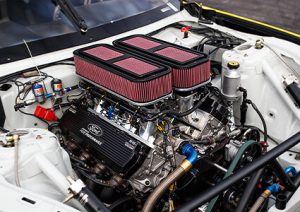
How K&N Engineering is helping vehicles, and now buildings, breathe better
As a global manufacturer of air filters, oil filters, and intake systems, K&N Engineering (K&N) is a business with quality, precision, and sustainability at its core. Providing a solution that combines performance requirements with sustainable practices, K&N offers an unrivaled air filter to several markets. Originally focused on the automotive industry, the business has since used its decades of expertise and industry knowledge to diversify into other sectors.
The company’s foundation is a truly unique story that begins with two motorcycle racing enthusiasts, Ken Johnson (K) and Norm McDonald (N), and their ground-breaking innovation. Determined to develop an air filter that could perform under the demands of dusty off-road environments, the pair experimented with numerous types of filter media until they found the solution – an oiled cotton design.
 Not only did the oiled cotton filter efficiently capture contaminants, but it also meant that the filter could be washed and reused. Thus, the original and now infamous K&N High-Flow Air Filter was born and the pair established a company with a manufacturing facility in California in 1969.
Not only did the oiled cotton filter efficiently capture contaminants, but it also meant that the filter could be washed and reused. Thus, the original and now infamous K&N High-Flow Air Filter was born and the pair established a company with a manufacturing facility in California in 1969.
Today, innovation still runs through K&N’s core as it continues to develop and enhance its industry-leading filtration technology. Aside from its renowned High-Flow Air filter, the business also offers cabin filters, oil filters, intake systems, and a vast range of accessories and cleaning products. Leigh Tomlinson, General Manager, K&N’s Global Markets, joins us to discuss the company’s heritage and its ongoing expansion into other markets.
“Our product’s biggest selling point is that it’s not only highly effective, but is designed to be washable and reusable, making it a much more sustainable choice as it significantly outlasts consumer alternatives,” Leigh begins. “Since Ken and Norm developed our original high-flow filter 53 years ago, we have developed filtration solutions for a number of applications across different categories. Our products go right across automotive, including cars, trucks, and motorcycles, ultimately helping vehicles breathe and perform better.
“Within the last five years specifically, we’ve taken our experience of improving airflow to new markets, particularly in what we call our industrial marketplace. We’re now serving a variety of customers in this space, helping organizations to eliminate tens of thousands of air filters going into landfill – and we’re only just getting started!
“To put it into perspective, there’s data out there that suggests 100 million air filters are discarded and end up in landfill every year, which gives you a sense of the challenge we’re working to overcome.”
As part of its diversification and expansion into new sectors, K&N is becoming a key player in the data center industry. “It all began when a major data center client approached us with a challenge,” Leigh narrates. “They were looking for a dust filter that could breathe better, but was able to be washed and reused, avoiding the hassle of constantly discarding and renewing tons of filters, particularly in a sustainable-minded era.
“Our technology has a high airflow with reduced resistance, which meant we could solve two problems in one for this particular customer – delivering performance and sustainability. This process effectively kickstarted our venture into creating a line of industrial and data center air filters, and it turns out that the very same formula that made our engine filters successful also works in data centers.
“The product has three big wins for the data center market. Firstly, our air filters are, as I’ve explained, washable and reusable, which minimizes the frequency of replacement, in turn dramatically reducing costs. Secondly, our low restriction technology results in higher air flow, meaning fans within the data center turn slower and thus save energy. The energy savings vary depending upon the type of data, but many of our customers report substantial savings.
“Lastly, our filters are a game changer when it comes to sustainability goals,” he continues. “With organizations facing ever-increasing sustainability demands and goals to cut down waste and transportation emissions, using our filters can have a significant impact on what is becoming an increasingly important customer environmental footprint.”
Such innovative products rarely come without state-of-the-art manufacturing facilities, and K&N is no exception. “In 2020, we moved our manufacturing operation from California to Dallas, Texas, which enabled us to integrate cutting-edge technology into our processes to ensure both efficiency and precision,” Leigh explains. “Our site features advanced conveyor systems and automated raw material routing to optimize the flow of material though our production process, ultimately reducing waste and improving production speed.
“We also employ advanced robotics to automate operations like milling and tube bending. By combining automated technology that optimizes processes with our filtration solutions we can quickly and consistently produce high-quality, sustainable filters for across a variety of applications.”
Turning to the future, Leigh details some of the challenges K&N are navigating: “The biggest challenge for us is deciding where to focus. If we take data centers, for example, they are everywhere, in every city in the world. While we’ve got an established presence in most countries across the globe, we’re the new guys within this space, so we must prioritize our time effectively and consider how to prove our concept in a critical infrastructure environment. We’ve invested in top talent from the data center space to not only help us build a five-year strategy, but also to understand how to communicate our product in a different way that enables us to understand key insights and needs of clients in this field.
“However, our filtration solution goes beyond data centers. If you think about industrial filtration, there’s manufacturing facilities, shopping centers, government buildings, and hospitals. That’s without exploring domestic and residential filtration for air conditioning units or domestic furnaces, for example. It’s a positive challenge to be faced with, but we must strategize how to pivot to where the opportunities are arising over the next ten years.
“It’s also important to note that there’s still a lot of innovation within the automotive industry. We’re bringing a new dry filter within our automotive product range, for example, which doesn’t need oil and can be cleaned in a different way, yet still offers the same features, benefits, and performance our customers have come to expect from us.
“There’s definitely a lot of room for us to grow even further,” Leigh concludes. “We’ll continue to solve problems for our existing customers while identifying opportunities to expand in different markets and add new clients to our portfolio.”